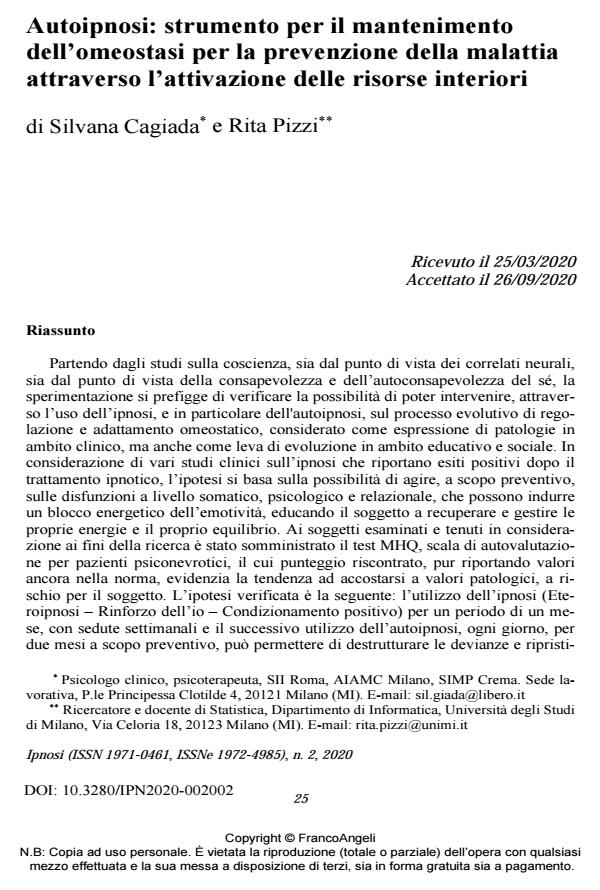Self-hypnosis: tool for the maintenance of homeostasis for disease prevention through the activation of inner resources
Journal title IPNOSI
Author/s Silvana Cagiada, Rita Pizzi
Publishing Year 2020 Issue 2020/2
Language Italian Pages 12 P. 25-36 File size 243 KB
DOI 10.3280/IPN2020-002002
DOI is like a bar code for intellectual property: to have more infomation
click here
Below, you can see the article first page
If you want to buy this article in PDF format, you can do it, following the instructions to buy download credits

FrancoAngeli is member of Publishers International Linking Association, Inc (PILA), a not-for-profit association which run the CrossRef service enabling links to and from online scholarly content.
Starting from the studies on consciousness, from the point of view of both neural correlates and awareness and self-awareness, the experimentation aims to verify the possibility of being able to intervene, through the use of hypnosis, on the evolu-tionary process of homeostatic regulation and adaptation, considered as an ex-pression of pathologies in the clinical field, but also as a lever of evolution in the educational and social field. In consideration of various clinical studies on hypno-sis that report positive results after hypnotic treatment, the hypothesis is based on the possibility of acting, for preventive purposes, on the somatic, psychological and relational disfunction, which can induce an energetic blockage of emotionali-ty, educating the subject to recover and manage their energy and balance. The subjects examined and taken into consideration for research purposes were ad-ministered the MHQ test, a self-assessment scale for psychoneurotic patients, whose score, while still showing normal values, highlights the tendency to approach pathological values, at risk for the subject. The hypothesis verified is as follows: the use of hypnosis (heterohypnosis ‒ positive conditioning) for a period of one month, with weekly sessions and subsequent use of self-hypnosis, every day, for two months for preventive purposes, can allow to deconstruction the deviances and restore the resources blocked in the body structure, bringing the subject back to consciousness, directing the learning towards the recovery and maintenance of homeostasis. At the end of the trial, the verification of the achieved results was corroborated by the re-administration of the MHQ test and the statistical evalua-tion of the outcomes, which proved to be significant. The positive outcome of the study suggests that therapists can apply the experimental method on a systematic basis, making possible a fast and definitive recognition of self-hypnosis ‒ as well as hypnosis ‒ as a scientific discipline.
Keywords: Heterohypnosis, self-hypnosis, maieutics, homeostasis, prevention
Silvana Cagiada, Rita Pizzi, Autoipnosi: strumento per il mantenimento dell’omeostasi per la prevenzione della malattia attraverso l’attivazione delle risorse interiori in "IPNOSI" 2/2020, pp 25-36, DOI: 10.3280/IPN2020-002002